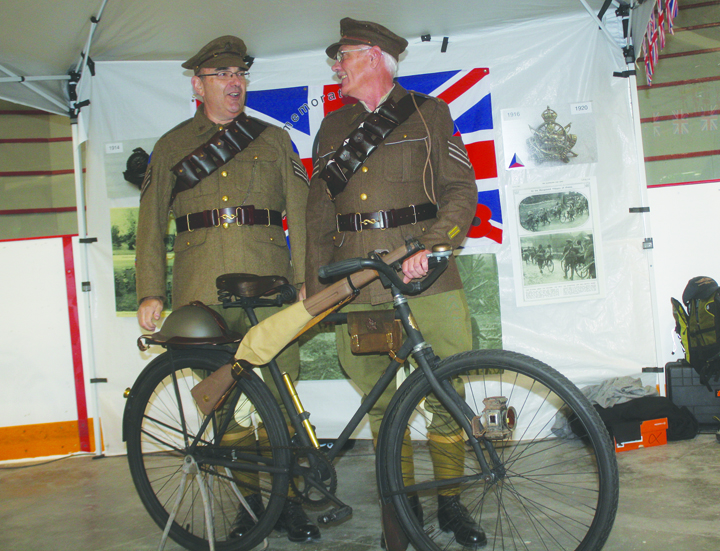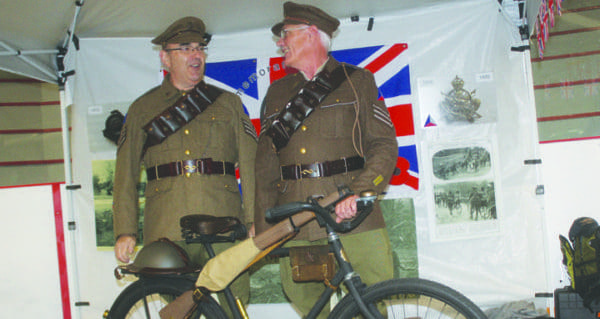
Martin Schultz (left) and Brad Christensen of Saskatoon dressed as Canadian soldiers for their exhibit detailing the exploits of and equipment used by the Canadian Cyclist Corps in the First World War at the Dusty Wheels Auto Show in Rosetown in September.
Crossroads staff
A little-known Canadian squad finally did the jobs they’d volunteered for, four years earlier, when they led the Canadian Corps surge during the final 100 days of the First World War.
Two retired RCMP officers who displayed artifacts of the Canadian Cyclist Corps in Rosetown this fall thought that authorities would give that 1,200-man unit special recognition as part of Remembrance Day ceremonies this year.
Remembrance Day falls on the centennial of the armistice ending the First World War – Nov. 11, 1918 – the reason the November date is designated as Remembrance Day.
Brad Christensen understood that the National Defence Department would honour the corps as part of the armistice centennial celebration.
[emember_protected for=”2″ custom_msg=’For more on this story, please see this week’s print edition of The Cross Roads.’]
“I said, ‘What’s that?’” Christensen, of Saskatoon, said at a cycle corps display with Martin Schultz during the Dusty Wheels Auto Show in Rosetown on Sept. 23. “ ‘I’ve been riding and working on bicycles my whole life. I’ve never heard of the Canadian cycle corps.’”
Units formed in 1914 with volunteers from across the country, he learned. They were joined together in 1916. Their training included cycling 40 to 50 miles a day, carrying 90 pounds of equipment, and engaging soldiers training for the infantry in mock, night-time battles, he said.
“They served – front line – all through the war,” remained in Germany afterwards as part of the Occupation force, then disbanded in 1920 after returning to Canada, he said.
Brigadier-General Raymond Brutinel became their commander after Brutinel, leading Canada’s automobile machine-gun brigade, decided units should work together.
Brutinel is credited with the Canadian creation of a “mobile, mechanized army,” Christensen said.
All armies in that war had soldiers on bicycles, he said. Until the final advance, they mainly delivered messages between trenches and buried the dead, he said. If German shelling caused a breach in the Allied lines, cyclists were to cover it until artillery or trench-mortar troops arrived. They also helped control traffic, filled sand bags, scouted and reported on enemy troop movements and helped engineers repair roads or build railroad.
“They did pretty much everything,” Christensen said.
After the Allies broke through the German lines at Amiens, France, on Aug. 8-10, 1918, “They actually got to do the job they were trained to do,” he said, riding ahead of infantry and mechanized forces to “take full advantage” by harassing the retreating enemy, taking advanced positions and holding them until trailing units arrived, he said.
“If you couldn’t hold the position, you were to give enough fire to keep the Jerries’ heads down until (commanders) could get an artillery or trench-mortar team up there to take out that (German) position,” Christensen said.
According to a Veterans Affairs Department item, “During the last three months of the First World War, the Canadian Corps advanced roughly 130 kilometres and took some 32,000 German prisoners and captured almost 3,800 enemy artillery pieces, machine guns and mortars. By the conclusion of Canada’s Hundred Days, 30 Canadians and Newfoundlanders had earned the Victoria Cross, the highest decoration for valour they could receive.”
The Canadian cycling soldiers rode bicycles made by CCM, some by a subsidiary, that cost the government $55 each. They were heavy-duty tradesmen’s or light, delivery bikes with shortened front fenders and heavier front-end suspension so they could carry a rifle, the Ross at first, then the Lee-Enfield. The Ross jammed if it wasn’t kept clean, difficult to manage in the mud of the trenches, Christensen noted.
Fighting forces still use bicycles, he said. Soldiers on bikes can travel two to three times the distance of those marching, he said.
“They’re quiet, cheap and easy to repair,” he added. “You lay them down; they disappear. But it’s not like the old days when they had entire battalions of (soldiers) on bicycles.”
Christensen and Schultz met years ago as boys from Prince Albert and Nova Scotia, respectively, at air-cadet camp, then were re-united as RCMP officers at Lloydminster. They had one restored bike from that period on display and another was being prepared for this weekend’s ceremonies in Saskatoon.
There, they’d been invited to lead an annual wreath-laying ride to memorial cairns by members of a cycling club.
“Now, people know nothing about the Canadian cycle corps,” Christensen said. “They won lots of individual medals but no battle honours. They were at every major battle the Canadians were at.”

